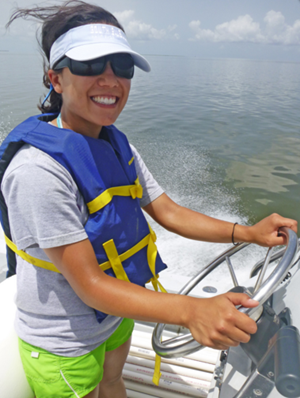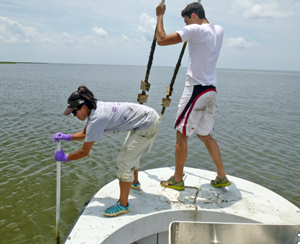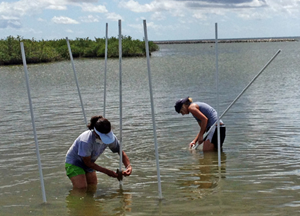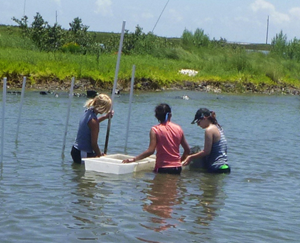
Maria Vozzo grades oyster larvae at the LA Sea Grant oyster hatchery. Here, she filters out smaller, younger larvae and collects larger ones ready to settle into spat. Two weeks later, Maria counted the spat that had grown on the tiles and placed the tiles in predator exclusion cages in the field. (Photo credit: Stephanie Grodeska)
Maria Vozzo’s strong interest in Deepwater Horizon research led her from North Carolina to Louisiana to study the oil’s effects on local oysters.
Her work has a wide scope, from the oyster’s environmental conditions to their cellular responses. Maria’s creative adaptation of commercial oyster equipment for her research may also improve them for fisherman’s use.
Maria is a master’s student in Biological Sciences at Louisiana State University (LSU) and a GoMRI Scholar with Coastal Waters Consortium (CWC).
Her Path
The great outdoors sparked Maria’s interest in science. As a child, she attended science-oriented camps as a way to get outside and then moved on to field ecology courses in college. When the Deepwater Horizon oil spill occurred, Maria knew that the impacts could be huge. She searched for ways to get involved, even as a volunteer, but found nothing. After graduating from the University of North Carolina (UNC) – Chapel Hill, she assisted a large oyster restoration project at the UNC Institute of Marine Sciences, sparking her interest in oyster research.
When Maria began exploring graduate schools, she found her way back to oil spill research. She contacted ecology professor Dr. Ken Brown after a friend recommended looking into LSU. Dr. Brown and his team had just applied for the CWC grant, and he needed a student. “I tried so hard to find opportunities down here, and it didn’t work out,” recalls Maria. “But now, here I am in Louisiana a few years later working on the project I became so interested in two years ago.”
Her Work

Maria Vozzo traveled each of the four Barataria Bay study sites – Hackberry Bay, Bay Jimmy, Grand Isle, and Grand Terre – during each field day. (Photo credit: Annette Hebert)
Oysters are important to Louisiana’s economy and environment. They support a large industry and provide marine habitat, filter water and stabilize shorelines. While oysters are generally tolerant, Maria explains that oil could compromise their long-term health and sustainability and decrease reef functions. After the oil spill, she had many of the same questions as locals about impacts on oyster reproduction and growth and on marine life living in oyster reefs. Maria’s research is helping to find answers.
Changes in recruitment, which describes the number of young oysters that settle in an area, may indicate if oil deters larvae from their usual sites, causing a decline in population density. Maria explains, “If they’re not settling and growing, then that’s not good for us or the oyster reefs.” Once larvae settle on a hard surface, they stay there permanently and are known as “spat” until adulthood. To monitor settlement success, she deploys cement tiles at oiled and unoiled sites in Barataria Bay, retrieves them monthly and records the number of settled spat.
Unexpected results led Maria to consider other factors that might affect oyster recruitment. “In 2012, there was no detectable recruitment difference between the oiled and unoiled sites, suggesting that oil presence had little effect. However, higher rainfall and flooding in early 2013 caused lower salinity at all sites and only unoiled sites experienced recruitment.” She hypothesized that simultaneous stressors such as low salinity and lingering oil might be influencing recruitment. Maria conducted lab experiments assessing spat cellular health under various levels of salinity, oil and sediment and found that all oil treatments weakened lysosomes – the cell structures that process nutrients and destroy waste.

Maria Vozzo (left) and intern Mitch Bogran (right) place recruitment tiles at Bay Jimmy. They collected the tiles one month later to quantify oyster recruitment. (Photo credit: Carmen Bray)
Maria realized that reef dwellers who feed on oyster spat, such as blue crabs, mud crabs and certain small fish, might also be affecting her results; so, she devised a clever way to determine their impact on recruitment. Knowing that fisherman use cages to protect oysters from predators, she built her own cages with different sized mesh openings, placed cement tiles with spat inside, and then deployed them at the study sites. She also used exposed tiles without cages. With assistance from Dr. John Supan at Louisiana Sea Grant’s Grand Isle oyster hatchery, Maria was able to “place tiles pre-set with spat and ignore other environmental factors that influence spat recruitment, such as oil or salinity, and then focus on predation.” She found that all cages deterred predators, allowing for approximately 50% or higher spat survival, while exposed tiles experienced almost 100% predation. “A lot of work goes into designing cages that exclude predators but still allow oysters to grow to harvestable sizes,” said Maria. “I hope this study can improve oyster cages.”
Maria’s results demonstrate the complexity of uncovering oil impacts. Her cage experiment suggests that salinity and predation may have more long-term impacts on oysters than oil; however, her lab experiments showed that short-term effects of oil contamination can be detrimental to spat health. Because of the later, Maria defended in her thesis that oil spill clean-up should be a priority to maintain healthy oyster populations.
Her Learning

Maria Vozzo (left) and Jenessa Kay (right) place recruitment tiles and commensal bags (used to collect the commensal reef communities at each site) at Grand Isle. (Photo credit: Bridget Rogers)
Maria had never worked on such an extensive project before, so she was delighted to experience the camaraderie among CWC scientists firsthand, “People were so willing to share their research and ask me about mine and bounce around ideas. I learned a lot about collaboration and communicating science.”
Maria feels that she is a more competent scientist, “I got to do a lot of field work and I’m more confident in designing a research project now.” She also learned how to solve problems and deal with less-than-ideal conditions. “A lot went wrong last year—salinity was really low and everything I planned was not going well. I had to figure out an alternative and work with the data I was able to collect. My biggest realization was ‘You know what? That’s data. It’s data in itself.’ I can’t control the weather or the bay’s currents. You have to do your best, get the data you can and see what you get at the end of it.”
CWC’s support of its student researchers means a lot to Maria. Recalling a recognition luncheon with scientists and administrators, she said, “Everyone was so supportive and appreciative of the work we’d done. They eagerly asked us questions about our work, and we enjoyed talking about it. It helped us refocus our energy on this project.” Maria also credits her success to her lab and the undergraduate volunteers she worked with, “They gave so much of their time and developed projects that enhanced our understanding. We wouldn’t have accomplished nearly as much without them.”
Her Future

Jenessa Kay (left), Maria Vozzo (center), and intern Bridget Rogers (right) collect recruitment tiles and commensal bags at Grand Terre in southeast Barataria Bay. (Photo credit: Annette Hebert)
Maria recently completed her thesis detailing her long-term study of Barataria Bay oyster recruitment and her predator exclusion study and is now preparing to publish results in scientific journals. She’s also applying to Ph.D. programs in Australia, where she will soon be living, and has found that GoMRI scientists were more than happy to share contacts and give her advice before she departs. Maria hopes that her experiences will help her transition into other beneficial, rewarding and exciting work.
Praise for Maria
Dr. Kenneth Brown recognizes Maria as a skilled and hard-working student who has made valuable contributions to the CWC project. Brown said that while Maria was working on her thesis she took on many responsibilities including the team’s sampling work, collaborating with her fellow research assistants, supervising a small army of biology undergraduates and teaching a lab. “Having Maria on the team really helped get the work done,” said Brown.
The GoMRI community embraces bright and dedicated students like Maria Vozzo and their important contributions. TheGoMRI Scholars Program recognizes graduate students whose work focuses on GoMRI-funded projects and builds community for the next generation of ocean science professionals.
Visit the CWC website to learn more about their work.
************
This research was made possible in part by a grant from BP/The Gulf of Mexico Research Initiative (GoMRI) to theCoastal Waters Consortium (CWC). The GoMRI is a 10-year independent research program established to study the effect, and the potential associated impact, of hydrocarbon releases on the environment and public health, as well as to develop improved spill mitigation, oil detection, characterization and remediation technologies. An independent and academic 20-member Research Board makes the funding and research direction decisions to ensure the intellectual quality, effectiveness and academic independence of the GoMRI research. All research data, findings and publications will be made publicly available. The program was established through a $500 million financial commitment from BP. For more information, visit http://gulfresearchinitiative.org/.
